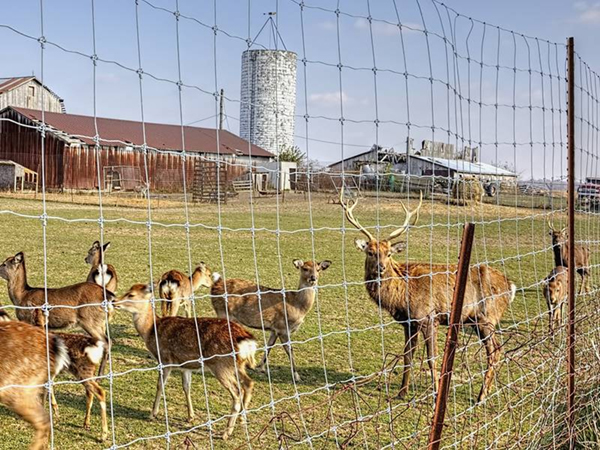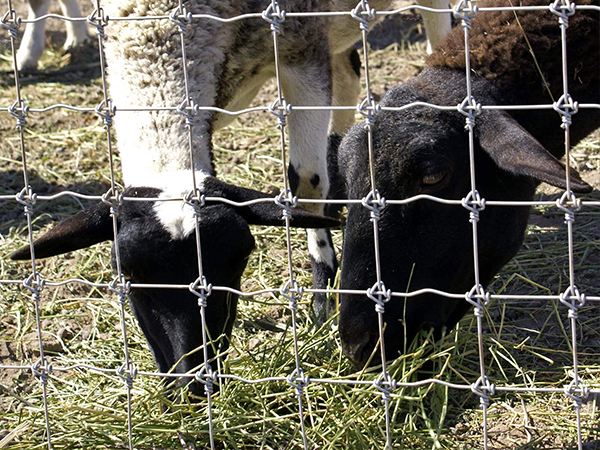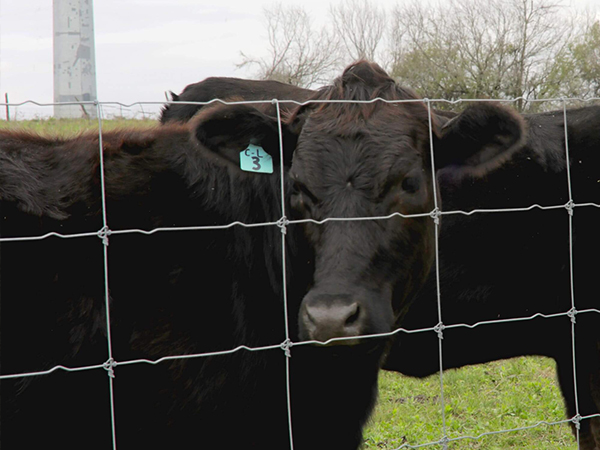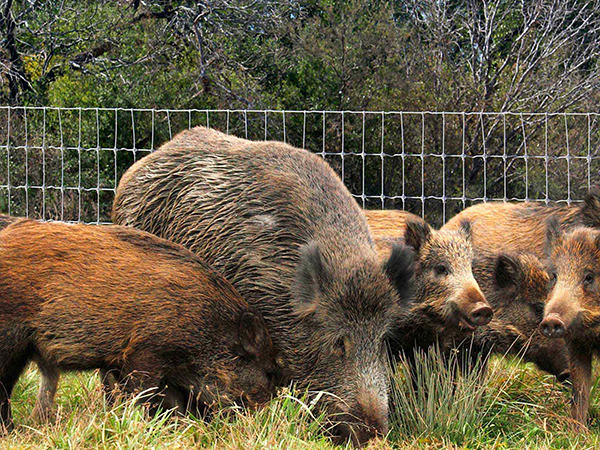High Tensile Wire Fixed Knot Fence for Agricultural Fencing
When selecting fixed knot fence, basic wire choices need to be made, including knot type, tensile strength, gauge, galvanization, and mesh spacing. In most applications, the best value is the fixed-knot, high-tensile, 12-gauge, Class-3 galvanized and with 6 inches or less mesh spacing characteristics. These combined qualities create a fence that is superior in value based on cost and performance.
For years, landowners have relied on low-carbon barbed wire and field fencing products made from steel wire with a carbon content of about 0.06-0.08% to enclose their land and control their livestock. But this type of wire tends to stretch, meaning it will sag or stretch over time.
Through technological advances, most people are now using fixed knot fences made of high tensile wire to hold their animals (deer, goats, cattle, horses & hogs, etc.), general livestock, wildlife and enclose their orchard.
High Tensile Wire
High tensile wire is made of higher carbon steel with a carbon content of about 0.28%. The increased carbon content significantly increases the wire's strength and reduces elongation.
It allows you to use a smaller diameter wire instead of a thicker low carbon wire. Once a high tensile wire fixed knot fence is properly installed, it will remain tight for years and will require very little maintenance over time.
Fixed Knot Fence for Deer
Fixed knot fence offers many benefits for deer control. Knots don't break or slide, the fencing resists impacts, and it doesn't stretch or sag. It resists access to deer's predators, and really cuts down on labor costs.
Fixed knot deer fence has less visibility and stronger structures to protect farms, gardens and orchards from deer and large animals.
Specification & Application

| Types | Fence Height | Horizontal Wires | Spacing of Vertical Wires | Where Used | Reason |
|---|---|---|---|---|---|
| EZFK17/75/6 | 75" | 17 | 6" | Internal fence for smaller deer species | Lower fences with 6" spacing save on materials costs – deciding factor is jump height of the species in question |
| EZFK20/96/3 | 96" | 20 | 3" | Breeding & fawn pens, high pressure areas | Tighter 3" spacing for greater strength & smaller animal control |
| EZFK20/96/6 | 96" | 20 | 6" | Boundary fence, medium-to-high pressure | Strong, cost-saving 6" spacing |
| EZFK20/96/12 | 96" | 20 | 12" | Boundary fence, deer exclusion, low pressure areas | 12" spacing for economy |
| EZFK23/120/3 | 120" | 23 | 3" | Breeding & fawn pens, high pressure areas | Strongest with 3" spacing |
| EZFK23/120/6 | 120" | 23 | 6" | Boundary fence, medium to high pressure | Strong, cost-saving 6" spacing |
| EZFK23/120/12 | 120" | 23 | 12" | Boundary fence, deer exclusion, low pressure areas | 12" spacing for economy |
Fixed Knot Fence for Horse
Major professional assets and recreational animals alike, horses are the pride and joy of the Western lifestyle. Without them, a ranch wouldn't be a ranch. Protecting them is of the utmost importance.
Enzar Metal offers an array of products to do just that. Fixed knot horse fences are less expensive to install than traditional horse fencing. Smaller spacing helps prevent horses' hooves and legs from crossing the fence. It also has corrosion and rust-resistant performance, and lasts three to four times longer than low-tensile horse fencing. It can even be used with rail fencing.
Specification & Application

| Types | Fence Height | Horizontal Wires | Spacing of Vertical Wires | Where Used | Reason |
|---|---|---|---|---|---|
| EZFK13/48/3 | 48" | 13 | 3" | Stalls, holding pens, runways | Short but strong 3" spacing |
| EZFK17/48/3 | 48" | 17 | 3" | Stalls, holding pens, runways | Short but strong 3" spacing |
| EZFK16/61/3 | 61" | 16 | 3" | Stalls, holding pens, runways | 3" spacing is durable, holds its shape, resists pawing |
| EZFK16/61/6 | 61" | 16 | 6" | Pasture & perimeter fence, low pressure areas | 6" spacing is economical, tall, resists downward pressure |
| EZFK17/75/3 | 75" | 17 | 3" | Handling areas, stalls, holding pens, crowded areas | Durable, tall, resists high pressure with 3" spacing |
| EZFK17/75/6 | 75" | 17 | 6" | Pastures, exterior, cross-fences | Durable, height discourages necking down |
Fixed Knot Fence for Goat
Those who raise stubborn sheep and goats understand just how challenging it can be to manage fencing. They're quick to get out and even harder to get back in once they escape.
And let's not forget how challenging it is to prevent predators, such as bobcats, foxes, coyotes, dogs, and even toothier animals.
Its economical fencing solutions are abundant, and the total construction cost of sheep & goat fixed knot fencing is more affordable than net wire with barbed wire. It resists rust and corrosion, offers superior strength, resists impact, has very low sag, and requires little to no maintenance.
Specification & Application

| Types | Fence Height | Horizontal Wires | Spacing of Vertical Wires | Where Used | Reason |
|---|---|---|---|---|---|
| EZFK8/42/3 | 42" | 8 | 3" | Pasture & exteriors, raceways, birthing areas, kid pens, holding pens, high pressure areas | 3" spacing for complete predator control – predators can't get through |
| EZFK8/42/12 | 42" | 8 | 12" | Pasture, interior, and cross fencing | Economical 12" spacing |
| EZFK9/49/12 | 49" | 9 | 12" | Pasture, interior and cross fence for larger goats, low pressure areas | Economical 12" spacing for bigger goats |
| EZFK13/48/3 | 48" | 13 | 3" | Pasture, exteriors, raceways, birthing areas, kid pens, holding pen | 3" spacing for complete predator control |
| EZFK13/48/12 | 48" | 13 | 12" | Pastures, exterior fences | Economical 12" spacing with predator control |
Fixed Knot Fence for Cattle
We provide a very strong, low maintenance cattle fence It's stronger than 9 gauge wire, resists ice and snow, maintains its shape, and resists rust and corrosion. Cattle/Bison may try to give the fence horns, but the fixed knot fence is tough enough to withstand.
Specification & Application

| Types | Fence Height | Horizontal Wires | Spacing of Vertical Wires | Where Used | Reason |
|---|---|---|---|---|---|
| EZFK9/49/6 | 49" | 9 | 6" | Internal & corral fence, high pressure areas | 6" spacing for greater strength |
| EZFK9/49/12 | 49" | 9 | 12" | Boundary & pasture fence, low pressure areas | Cost saving with 12" spacing over long distances |
| EZFK16/61/3 | 61" | 16 | 3" | Corrals, high pressure areas | Higher fence, 3" spacing for maximum strength and animal control |
Fixed Knot Fence for Hog
Wild hogs are a significant threat to property owners throughout the southern United States.
Landowners will prefer fixed knot fences for many reasons. First, its woven, fixed-knot design limits entry and breaches in the fence.
Even when unruly hogs press and wallow against the fence, the knots hold strong. It provides great elasticity when they engage the fence, and returns to its proper resting position after they disengage. Plus, it's super cost-effective and high value.
Specification & Application

| Types | Fence Height | Horizontal Wires | Spacing of Vertical Wires | Where Used | Reason |
|---|---|---|---|---|---|
| EZFK7/35/6 | 35" | 7 | 6" | Feral hog exclusion, pasture, interior and cross fence | Exclusion fence, economical 6" spacing |
| EZFK8/42/3 | 42" | 8 | 3" | Feral hog exclusion, turn-outs, birthing areas, holding pens, high pressure areas | 3" spacing for complete predator control – predators can't get through |
| EZFK8/42/6 | 42" | 8 | 6" | Feral hog exclusion, pasture, interior and cross fence, medium to high pressure areas | Exclusion fence, economical 6" spacing |
| EZFK13/48/3 | 48" | 13 | 3" | Pasture, exterior, turn-outs, birthing areas, hog pens, holding pens | Predator control |
| EZFK9/49/6 | 49" | 9 | 6" | Feral hog exclusion, pasture, interior and cross fence, medium to high pressure | 6" economical spacing for larger animals |
Fixed Knot Fence for General Livestock
General livestock fence provides safe containment for all the valuable livestock on your property. We construct our fences using high-tensile, galvanized wire that is corrosion resistant and weathering for optimal results. This low fencing can be used in various types of terrain for multiple types of animals.
Specification & Application

| Types | Fence Height | Horizontal Wires | Spacing of Vertical Wires | Where Used | Reason |
|---|---|---|---|---|---|
| EZFK7/35/6 | 35" | 7 | 6" | Feral hog exclusion, pasture, interior and cross fence | Low pressure areas, economical 6" spacing |
| EZFK8/42/3 | 42" | 8 | 3" | Feral hog exclusion, raceways, birthing areas, holding pens, high pressure areas | 3" spacing for complete predator control – predators can’t get through |
| EZFK8/42/6 | 42" | 8 | 6" | Feral hog exclusion, pasture, interior and cross fence, medium to high pressure areas | Economical 6" spacing |
| EZFK13/48/3 | 48" | 13 | 3" | Pasture, exterior, raceways, birthing areas, hog pens, holding pens | 3" spacing for complete predator control |
| EZFK12/48/12 | 48" | 13 | 12" | Pastures, exterior fences | Economical 12" spacing with predator control |
| EZFK9/49/6 | 49" | 9 | 6" | Feral hog exclusion, pasture, interior and cross fence, medium to high pressure | 6" economical spacing for larger animals |
| EZFK9/49/12 | 49" | 9 | 12" | Pasture, interior and cross fence for larger goats, low pressure areas | Economical 12" spacing for bigger goats |
| EZFK16/61/3 | 61" | 16 | 3" | Stalls, holding pens, runways | 3" spacing is durable, holds its shape, resists pawing |
| EZFK16/61/6 | 61" | 16 | 6" | Pasture & perimeter fence, low pressure areas | 6" spacing is economical, tall, resists downward pressure |
Fixed Knot Fence for Orchard & Wildlife
Healthy orchards need a great trellis system to support heavy fruit, plus protection from hungry deer, birds and other predators. Safeguard your trees from the perimeter and overhead predators with a fixed knot fence and provide the necessary support with trellising materials.
Specification & Application

| Types | Fence Height | Horizontal Wires | Spacing of Vertical Wires | Where Used | Reason |
|---|---|---|---|---|---|
| EZFK17/75/3 | 75" | 17 | 3" | Handling areas, stalls, holding pens, crowded areas | Durable, resists high pressure with 3" spacing |
| EZFK17/75/6 | 75" | 17 | 6" | Pastures, exterior, cross-fences | Durable, height discourages necking down |
| EZFK20/96/3 | 96" | 20 | 3" | Breeding & fawn pens, high pressure areas | Tighter 3" spacing for greater strength & smaller animal control |
| EZFK20/96/6 | 96" | 20 | 6" | Boundary fence, medium-to-high pressure | Strong, cost-saving 6" spacing |
| EZFK20/96/12 | 96" | 20 | 12" | Boundary fence, deer exclusion, low pressure areas | 12" spacing for economy |
| EZFK23/120/3 | 120" | 23 | 3" | Breeding & fawn pens, high pressure areas | Strongest fence with 3" spacing |
| EZFK23/120/6 | 120" | 23 | 6" | Boundary fence, medium to high pressure | Strong, cost-saving 6" spacing |
| EZFK23/120/12 | 120" | 23 | 12" | Boundary fence, deer exclusion, low pressure areas | 12" spacing for economy |
The variety of fence types for fixed knot fence can seem daunting at first. Grouping these fence pattern options by the intended use makes it much easier to make your fencing decision. For a more detailed discussion of the right fixed knot fence for your use, contact Enzar Metal fence expert







